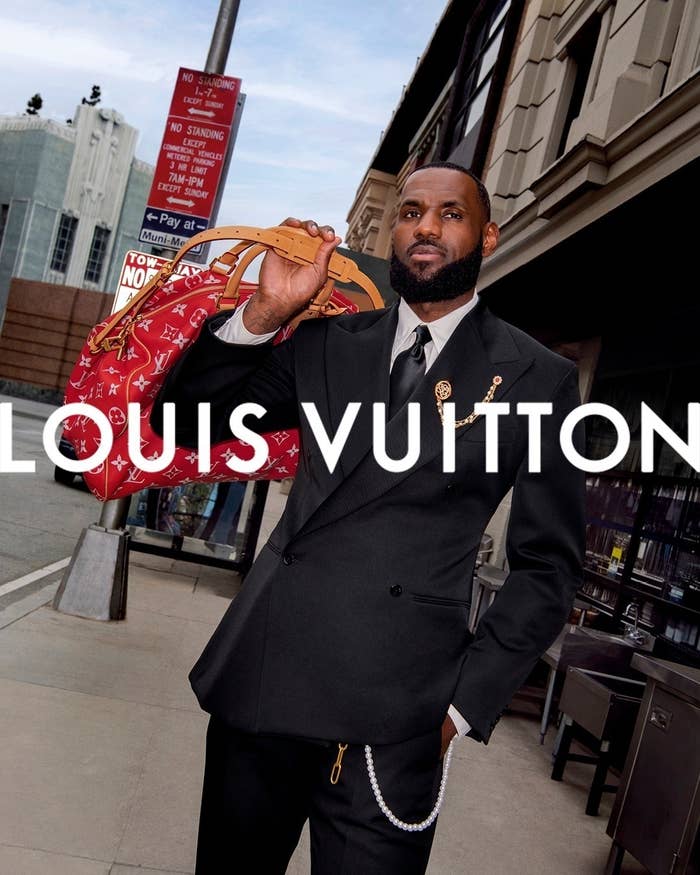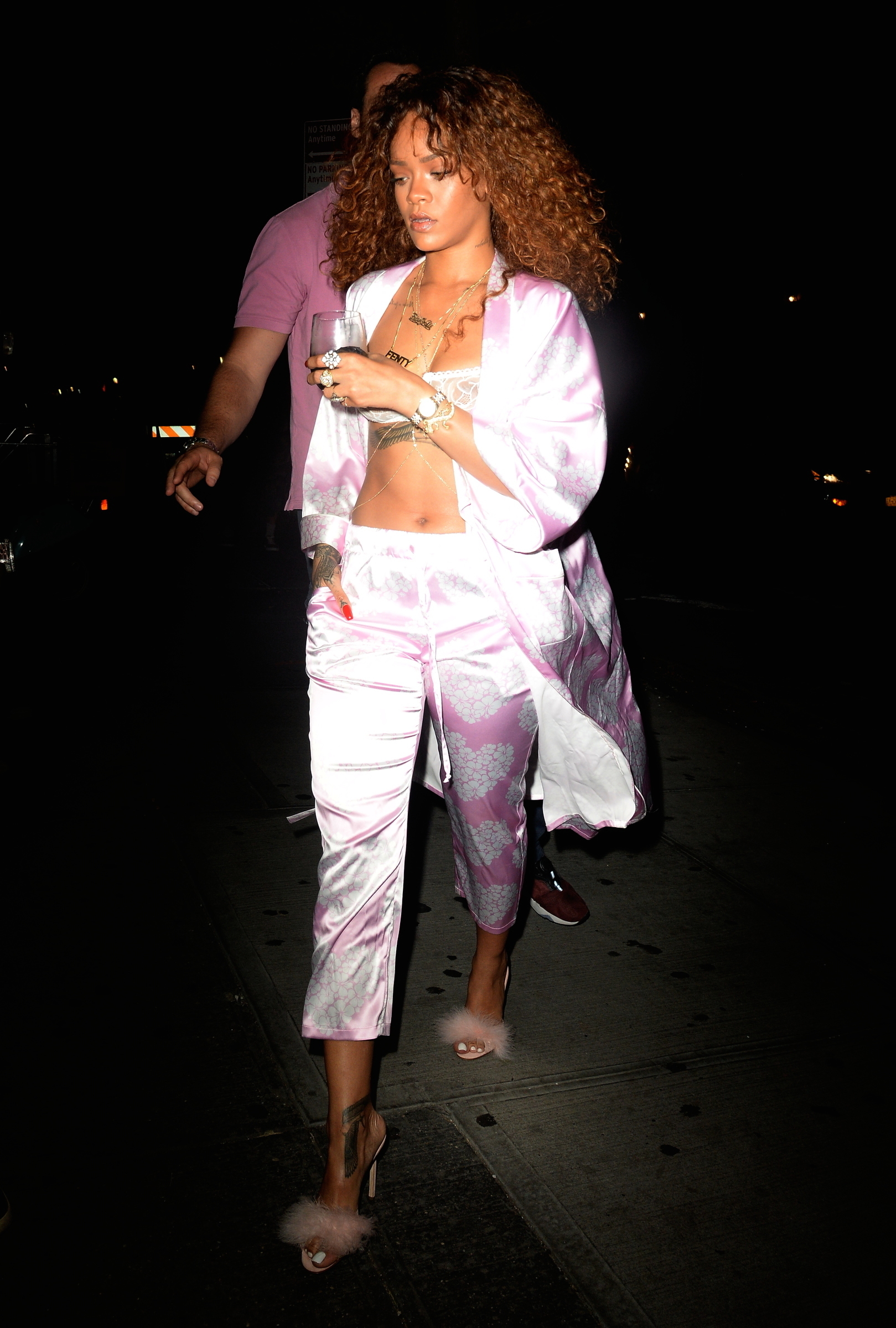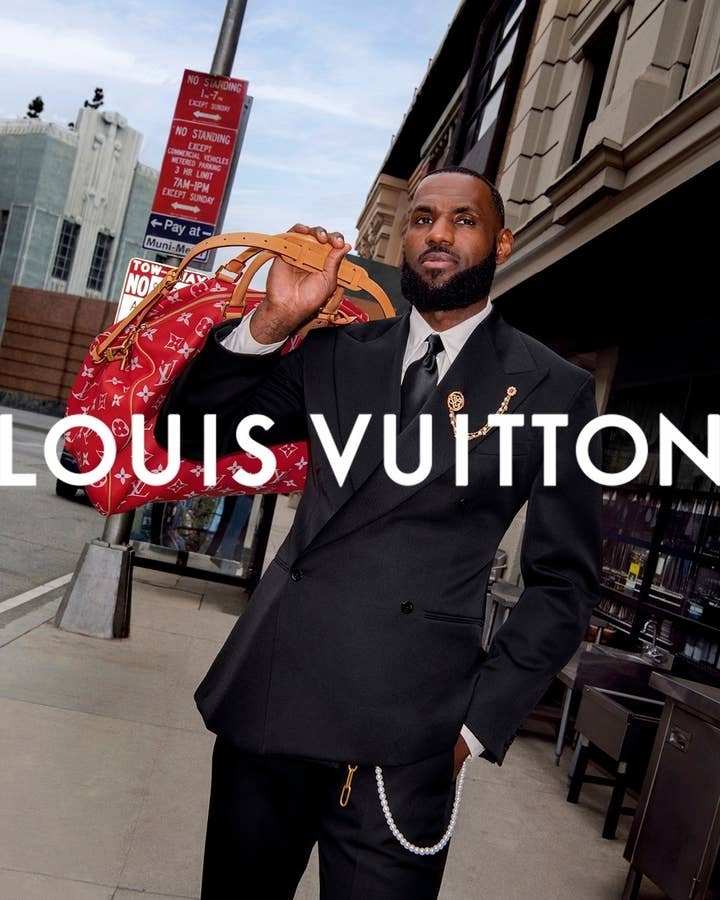
Shortly before Pharrell Williams was named men’s artistic director at Louis Vuitton, Martine Syms received a phone call from his team requesting that she direct two separate video campaigns starring Rihanna and LeBron James. After the call, a few ideas immediately came to mind.
“I was thinking about all these amazing images of her walking on the street with wine glasses,” says Syms, who then found out Rihanna was pregnant, so she had to pivot.
But Syms, a 36-year-old artist, still captured that powerful yet effortless essence that Rihanna embodies. Syms is known for using found footage from pop culture and integrating it into her work. She recently exhibited a piece that features a clip of Jay-Z dissociating after his Hot 97 Summer Jam performance in 2001 (more on that below). She’s also made and directed her own film, The African Desperate, which follows Palace Bryant (played by Diamond Stingily), a recent MFA grad who is navigating her final day of art school.
But now she was tasked with directing a fashion campaign with two huge stars that felt aspirational but still relatable and reflected Pharrell’s vision for the house, all within the span of 40 seconds.
“I was thinking about the opening sequence of a movie,” says Syms over the phone. “And I was thinking about how the Speedy bags are inspired by Canal Street. And how Pharrell is introducing these new bootleg colorways that you weren’t previously able to get from the brand. And just having fun with that idea.”
Here, Syms describes the specific references she looked to, what it was like directing Rihanna and James, Pharrell’s energy on set, and her overall approach to making a fashion campaign feel meaningful.
How did this come about?
I had an existing relationship with the team at LV. So I wasn’t that surprised when I got the call. But I was very excited. I had just been working on an exhibition that was about to open. And a part of me was like, I have a lot to do right now. Today is my opening. But at the same time, I was like, there's no way I'm saying no. So I think it was one of those kind of moments, which I'm sure we all have where it's like, yeah, I'm gonna be really tired this week, but it's worth it.
What was the goal for you with both 40-second video campaigns? What did you want to come across? Did Louis Vuitton give you a prompt?
I knew that Pharrell was coming in. They reached out in the morning and on the same day I was on the phone with everybody and we kind of talked through some concepts. It was very fast. So I put together some ideas based on what their thinking was, and what I knew about the collection, and obviously thinking about who the two people were and how they fit in the realm of this wider campaign.
What were the references, because I know you collect a lot of imagery and videos?
I was thinking about the opening sequence of a movie. And wanting it to feel like it was an introduction to a new era of the house with Pharrell being there. I also wanted it to be on the street. I think everyone was excited that you could reinvigorate something and bring the energy of the street to this luxury brand. And I was thinking about how the Speedy bags are inspired by Canal Street. And how Pharrell is introducing these new bootleg colorways that you weren’t previously able to get from the brand. And just having fun with that idea. With Rihanna, I was thinking about all these amazing images of her walking on the street with wine glasses.
And there were a couple other films I was thinking about. Roma was one actually. There's like a long tracking sequence I like. Chungking Express, there’s one piece of that film we were looking at. I worked with DP Chayse Irvin on both of the campaigns. Between the givens of our production schedule and the ideas we had, we were both excited to make something that felt this way. It had a little grit to it but was still pretty.
How was it directing these two big stars, Rihanna and LeBron? What did you want to get out of them? How was it directing them?
With LeBron, I wanted him to just look really hot. LeBron has this perfect skin. He’s in amazing shape. And I don’t feel like we always get to see Black men in that way. I really loved how Jerrod Carmichael looked in his special. His skin was good. The color. His hair looks good, you know? So that was important to me. And LeBron was wearing the suiting collection. And he wore these pajamas with paintings from Henry Taylor. And he was wearing this pearl necklace. All the accessories were just really lush and kind of textured. So that was something I was wanting with him. I wanted the LeBron campaign to actually feel a little bit more aspirational in that way.
And then with Rihanna, I was kind of repeating in my head this idea of like an everyday carry, which is a little bit of a play on words. It is a term people use online for what they pack every day, but it’s more associated with survivalists or camping gear. But I like the idea of thinking about it as like, carry. Like I’m doing the most. And the bag is something you want to be with you every day. So I was thinking about Rihanna being this icon of the people. We love her. And obviously we’ve seen her in 100 percent glam at the Met Gala or in videos, but she’s even like that when we see her on the street.

Did her being pregnant change your approach at all?
I mean, it made me not include the wine glass. That was the original vision but we kind of couldn’t do that.
You’ve directed actors before. How did you approach directing these big celebrities?
Somebody recently asked about my directing philosophy and I've been thinking about it. What I love about making films is basically it always feels like you're opening some weird portal due to all of these people’s energy. Whether you are making something with three people or 300 people, everybody's bringing their experiences there. Whatever happened to them in the past. Everyone is bringing their lifeforce. And that is like a really powerful thing. And I think with these two people, they are truly like megawatt stars, and they have that feeling to them. And I just wanted to let that shine. But also, there’s the logistics to getting the thing done. I am not the most starstruck kind of person. So it was more about having fun. They're putting a lot of trust in me to not look goofy. And both of them were very willing to listen and trusted my vision. And the Louis Vuitton team as well. Pharrell was on set, but I really tried to keep them in the video village so they could look at what we were doing through a screen and they could give me and my team the space to make something cool.
Did y'all shoot in LA?
Yeah.
I'm also curious about the lighting for both campaigns. Because it feels like it’s almost dusk. Or kind of like an overcast. And for Rihanna’s it felt more nighttime.
For Rihanna we shot at night and wanted the storefronts to be illuminating. But otherwise, that’s something we kind of decided to add in the grade just to make it feel a little bit more real. It was feeling too clean to me. I’m really interested in transitional times of day. It just gives it more depth and makes it more full. Some of the references we pulled were Jamel Shabazz photos. I was also looking at one walking sequence in Taxi Driver that was slo-mo. I wanted it to be a little seductive.
I also loved the music. Can you talk about that?
We worked with Asma Maroof and Daniel Pineda on music. I've worked with them a lot. And they're both super talented longtime friends and collaborators.
What were you all trying to do with the music?
I sent them a couple different cues. I wanted it to feel like you're in the city with a little bit of the hustle and bustle. I wanted it to sound like I have places to go and people to see. I told you about that opening sequence idea, but you know when you see someone from across the street or down the street and they look really good? And you track them down wherever they are going? I feel like this happens to me less in LA, but it happens a lot in New York, or Paris. I wanted the piece to sort of have that. Because we all know what that’s like. Sometimes you are like, I need that jacket. That’s sort of the feeling I wanted it to have.
I know costuming is important to you, but I’m assuming they told you ahead of time what the clothes would be. Did you have any say?
We had great stylists who worked on this. Jahleel Weaver and Matthew Henson worked with Rihanna. We talked about concepts and they pulled a lot of great stuff and had everything laid out. The collection is really fun. There were so many cool pieces in it and I was interested in texture and having some color. Matthew and Cactus Plant worked with LeBron.
What was Pharrell’s feedback when he saw the campaigns?
He was really hype on set. He’s very encouraging. He's one of my heroes, so I'm always happy to work with people like that. As I was walking through the plan for the day, he was super encouraging. He was kind of like, Martine you get it, just do your best. Go off. It was fun. He was there the whole time and it was very collaborative. Be Good Studios. It was just a lot of people I enjoy working with.
You're an artist and you're a thinker. And I know you've worked on fashion ads before. But what's your overall impression of fashion campaigns and their purpose?
What I try to bring to these projects… if I think about it in terms of a subculture, and I know that’s a funny thing to say about Louis Vuitton. But my friend actually sent me this thing that said art is the spiritual expression of culture. And so I kind of think of subculture similarly, meaning it’s a spiritual expression of a group of people or a culture. So if I just think of what the brand is, and I pretend it's punk or it's hip-hop or whatever. And if you think of a brand that you love, it's like, what would you distill that to? And what would make you be a part of that? And what I tried to tap into. Part of that is having some strong images. I feel like images are really powerful, obviously. It’s really a way of visioning and what can we vision? And sometimes you have more time to do that or less time, but I try to approach it from that place.
And congrats on the success of your film The African Desperate. So clearly you are very interested in filmmaking. Are you thinking about the next project?
I'm working on the next project. That’s been my focus the last couple of months and it will be my main focus this year.
Are you able to offer anything info on what it’s about?
Unfortunately, no. But it's coming soon.
OK, that's exciting. And I was reading up on your exhibition Present Goo that showed last year in London, and there was a video of Jay-Z dissociating? Oh, was it that one post his Summer Jam performance with Damon Dash speaking?
Yes.
So you said you could really relate to that. Why?
Have you ever been in one of these moments where you finally achieved something you've dreamed of or got something you really wanted, and then the dream is always different than the reality? Even when it's at its best. I was talking to my friend last night about this because she's having an incredible year. Unlike most of us in 2023, she had a great fucking year and she was like, “It's pretty crazy to get everything you want.” And I think it is really a crazy feeling. And I think sometimes when that happens, you start evaluating shit.
That’s funny. Because I’ve watched that clip and you assume he’s being silent so Damon can talk shit for him. But you looked at it as if he was thinking deeply about the state of things.
We will never know. But I know the look of dissociated.



